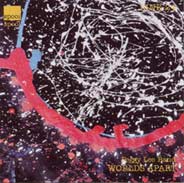
Peggy Lee Band
Worlds Apart
(Spool)
It
was on the cover of an album by René Lussier – Le Tour Du Bloc,
released in 1995 – that I first read the names of cellist Peggy Lee
and of drummer/percussionist Dylan van der Schyff, appearing as members
of the large Canadian ensemble called NOW Orchestra that on that album
performed some compositions written by the guitarist. I met again the
NOW Orchestra – and so, Lee and van der Schyff – on two albums by trombonist
and composer George Lewis: first, playing on a composition included
on his fine album titled Endless Shout (2000); then, on the full length
of a CD: the very good The Shadowgraph Series (2001). But it was two
releases in trio that made me really appreciate them: Floating 1…2…3
(2002) showed them brilliantly playing live alongside saxophone/clarinet
player Michael Moore; while The Flying Deer (2003) saw van der Schyff
in Holland, in nice conversation with Tobias Delius and Wilbert de Joode.
Lee
and van der Schyff are also members of the Peggy Lee Band, a line-up
(this is their third album) whose main occupation is to perform Lee’s
compositions. I had liked Sounds From The Big House (2002), even if
I didn’t consider it to be in the "excellent" category – I’m
pretty sure that the fact that the long track that (at least, to my
ears) sounded as being the least memorable opened the record had some
part in diminishing my enthusiasm. Though the line-up is of the kind
that for practical reasons are filed under "jazz", I’d suspect
the leader’s background to be more varied than that (I seemed to detect
traces of Fred Frith in his "New York period", and of the
group President); and while the timbre of her cello in solo mode reminded
me of Tom Cora, I’d call the title-track an homage to Wayne Horvitz
(both the composer and the arranger), circa Miracle Mile.
Worlds
Apart sees the sextet (on some tracks they add Ron Samworth on guitar)
sporting the same brilliant front-line of Jeremy Berkman (on trombone)
and Brad Turner (on trumpet, cornet and flugelhorn) that had been such
a big part of the reason why the previous album had been a success.
Here Dylan van der Schyff works mostly as a timekeeper, but he also
brings the nice colours that come from his work as an improviser (just
listen to how fresh his brushes work on the snare sounds in the opening
moments of A Door). Tony Wilson’s work on guitar sounds convincing to
me, but it doesn’t make me entirely happy. It’s not easy for me to judge
bass player Andre Lechance – but here the point appears to be a certain
reticence on the part of the leader, who’s ready to use the cello as
a solo voice together with the winds but who seems somewhat afraid of
filling the bottom for fear that it could make the top melody lines
less clear to perceive.
This
time, too, the opening track – Worlds Apart, somewhat reminiscent of
President/Curlew, with nasty guitar lines – was the one I liked the
least. Then we have the nice melody of the following track, Soft Scrape,
with nice work by Berkman and Turner and an arrangement that reminded
me of late-70s Carla Bley; and the stylistically varied Retracing 2.
I found the melodically fragmented First Spin to be curiously reminiscent
of something Robert Fripp could have written (and maybe he did). I liked
the last three tracks – Beekeeper’s Club, the long A Door and Lookout
– quite a bit. Berkman’s work on trombone – both solo and counterpoint
– is of high caliber. I noticed that Turner’s solos sometimes reminded
me of Mark Charig in his more melodious moments.
Nicely
recorded, Worlds Apart sounds quite fresh and pleasant, if not terribly
innovative. The only criticism I have is that – though she’s clever
and refined as an arranger – the leader doesn’t sound as being able
to compose those melodies that make one recognize their composer after
just a few notes yet. Maybe on her next record?
Beppe
Colli
©
Beppe Colli 2005
CloudsandClocks.net
| Feb. 6, 2005


